4-13-1 Embed forms
About embed forms
Embed form is a feature to merge multiple forms into one. This feature allows you to merge form definitions created as separate parts, such as header, body and footer, into a single form.
As it is possible to design the parts of the form separately, form design can be performed as a team.
In addition, making the common design parts such as company name, address or logo an embed form improves the maintainability of the form.
In this section, forms where embed settings are made are called "parent forms" and forms where these parent forms are embedded are called "child forms".
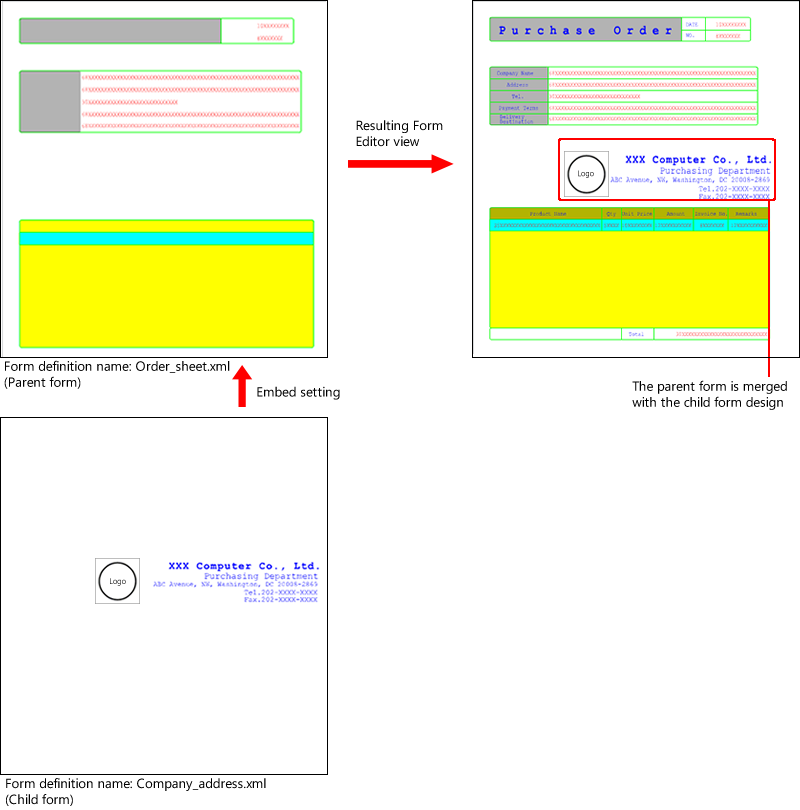
Schematic view of embed forms
Layer order for embed forms
The order for layering items in an embed form is as follows:
For the same type of item, or items placed in the added layer with the same name, the items placed on the parent form are placed at the back, and the items placed on the child form are placed at the front.
For items of different types, and which are Basic mode items only, they are placed at the front in the order of rectangles, straight lines, static text, fields, barcodes and images.
For items of different types, and which include Graphic mode items, they are placed at the front in the following order: layer order shown when details are shown in the System layer, Layer 1, Layer 2, Layer 3, ...Layer n.
Order | Items with the same type/ Added layer with the same name | Items of a different type | |
|---|---|---|---|
Basic mode items only | Graphic mode including items | ||
 | Items placed in the parent form Item | Rectangle | Order of layers shown when details are shown in the System layer Layer order |
Items placed in a child form Item | Straight line | Layer 1 (Additional layer) | |
Static text | Layer 2 (Additional layer) | ||
Field | Layer 3 (Additional layer) | ||
Barcode | ... | ||
Image | Layer n (Additional layer) | ||
Set embed forms
This explains how to make the settings for embed forms.
Click the
 References button on the left toolbar.
References button on the left toolbar.Select Embed forms in the References window, and click the
 Add file(s) to the form definition button.
Add file(s) to the form definition button.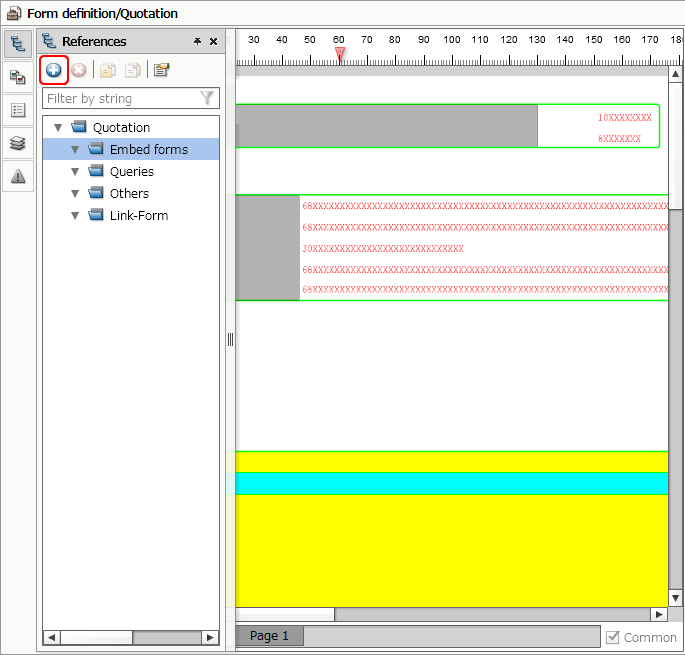
Select "Embed forms"
Specify a child form definition from the Open dialog and click the OK button.
The child form is added to Embed forms. Then, the referenced child form appears on the form editor screen.
Restriction
Operation is not guaranteed when an item of the same name exists in both a parent form and a child form.
Up to ten form definitions can be added to an embedded form.
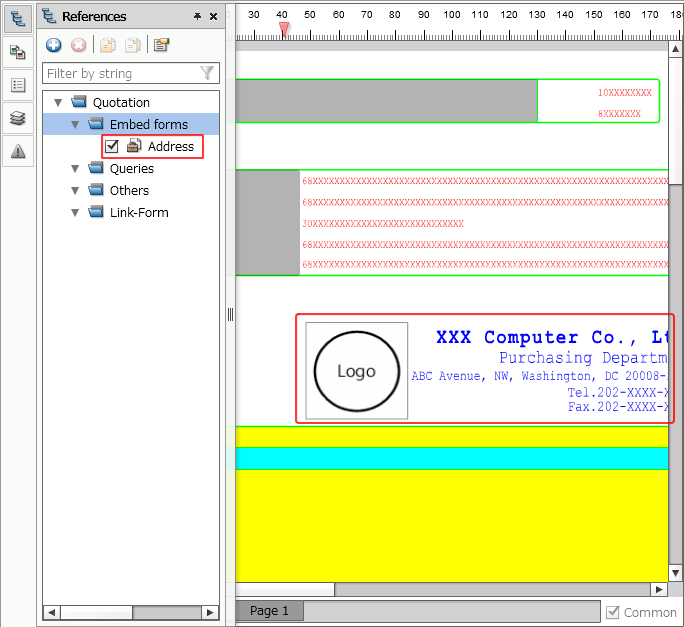
Referenced child form appears on the form editor screen
Select an added child form on the References window.
Configure the various property settings of the added child form with the Properties Editor.
Set the child form properties
Set child form properties.
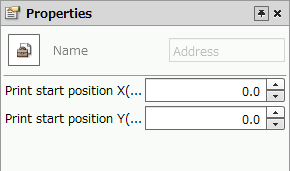
Child form properties
Item | Description |
|---|---|
Name | The file name for the child form is entered. It cannot be changed. |
Print start position X(dot) | Specifies the X coordinate of the start position of the child form. You can also change the value by clicking the ReferenceThe position of the child form can be changed using the mouse as well. For details, see "Change embed form position" in this section. |
Print start position Y(dot) | Specify the Y coordinate of the start position of the child form. You can also change the value by clicking the ReferenceThe position of the child form can be changed using the mouse as well. For details, see "Change embed form position" in this section. |
Show/hide embed forms
You can switch between showing or hiding child forms while editing the parent form.
To hide a child form, remove the check from the child form you wish to hide in Embed forms on the References window.
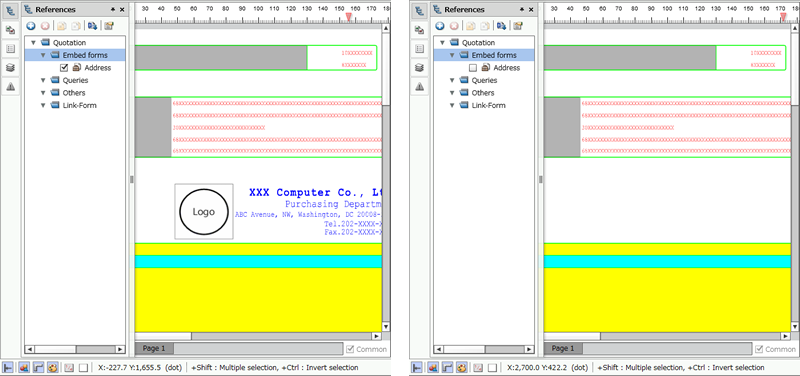
With the check box of the child form selected (left) and cleared (right)
Caution
Showing or hiding an embed form affects the show or hide setting during design and not the show or hide setting of the output.
Change embed form position
The position of the child form can be changed using the mouse.
The procedure to change the position of the child form using the mouse is as follows:
Click the child form to change its position on the References.
The child form placed on the Form Editor will be in the selected state.
Move the mouse over the area of the selected child form.
While the mouse cursor display changes to
 , refer to the guidelines and drag it to the desired position.
, refer to the guidelines and drag it to the desired position.The child form position is changed.
The figure below is an example of changing the position of "ChildForm2".

Change the layer order in embed forms
When there are multiple child forms, you can change the order in which these forms are layered.
The procedure for changing the layer order of child forms is as follows:
Click a child form to change its layer order on the References.
Click the
 Send to back button or
Send to back button or  Bring to front button.
Bring to front button.The child form's layer order is changed.
The figure below is an example of bringing to the front the "ChildForm1" child form that was at the back.

Notes
The parent form and the child form will be merged with the upper left corner aligned.
If items placed in the child form fall outside the print range of the parent form, only those items within the print range will be output.
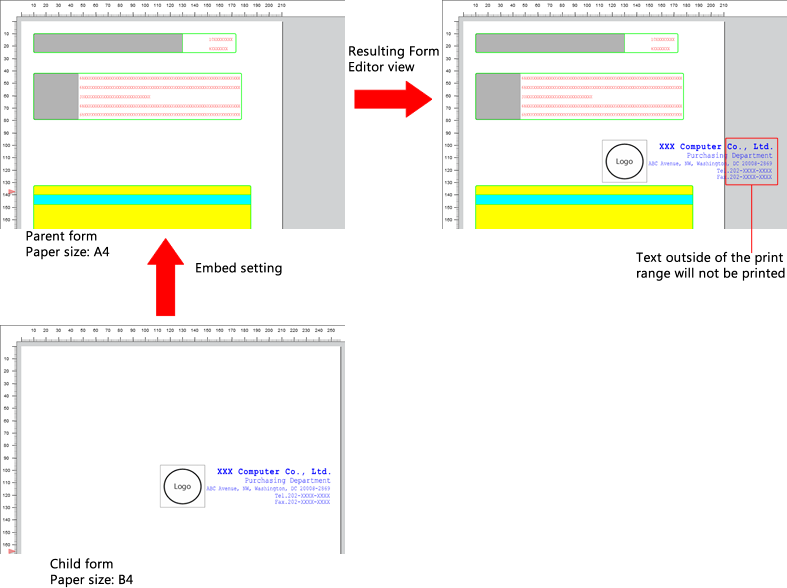
If placed outside the print range of the parent form
The child form design cannot be changed in the parent form. To change the design, open the form definition of the child form and edit it.
Restrictions
The following restrictions apply when using an embed form:
When a font name added to a child form does not exist in the parent form, items specified with that font in the child form have their font changed to the first font in the parent form font list.
When a color added to the child form does not exist in the parent form, items specified with that color in the child form have their color changed to white.
When a layer added in the child form does not exist in the parent form, items placed in that layer are not shown.
When the settings information is different for parent and child forms, the following parent form settings apply:
Show/hide layer settings
PDF layer settings
Paper properties
Font setting
Color palette
Page color
Barcode element size
When the resolutions of the parent and child forms are different, output is matched to the parent form resolution.
Operation is not guaranteed when an item of the same name exists in both a parent form and a child form.
Operation is not guaranteed when a formcopy exists in a parent form and in a child form respectively.
A parent form with a child form configured cannot be referenced as a child form.
A subform should be designed to be one parent form and one child form. Operation is not guaranteed when a parent form and a child form contain a subform respectively.
Do not use repeats, subforms, or records in both parent and child forms.
Do not include a child form within repeats, subforms, or records.
If you use a repeat, use only one in a parent form and a child form.
